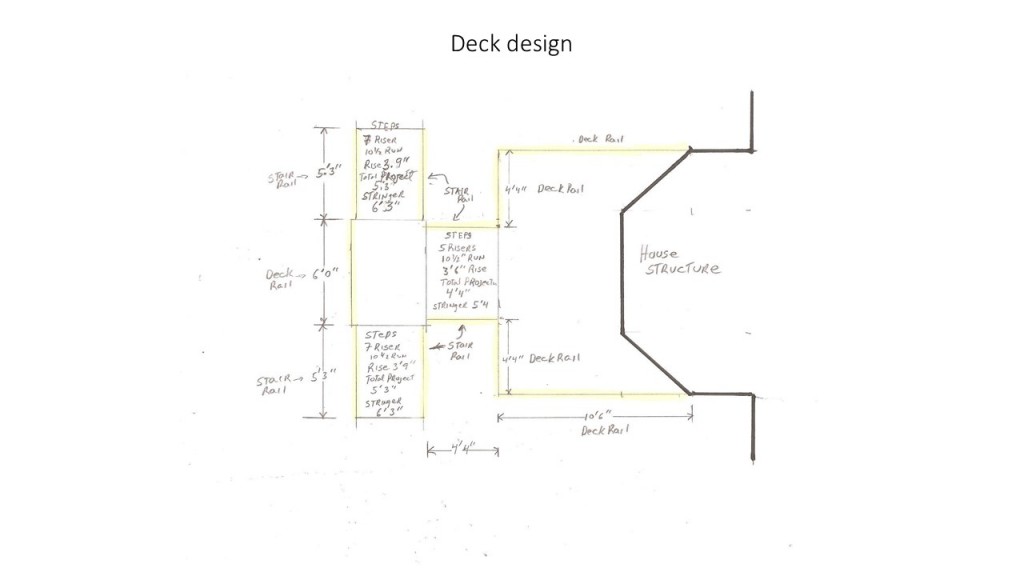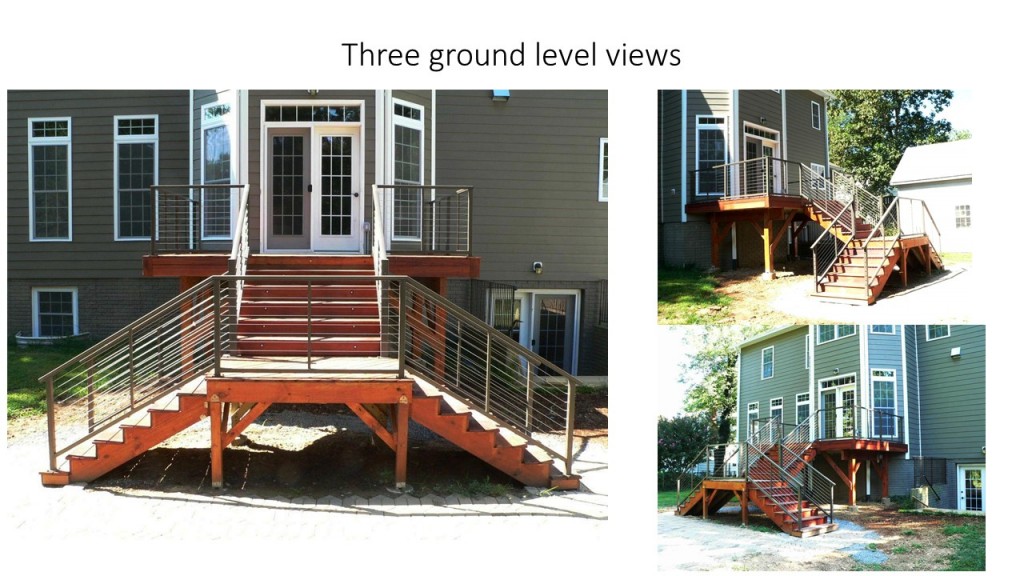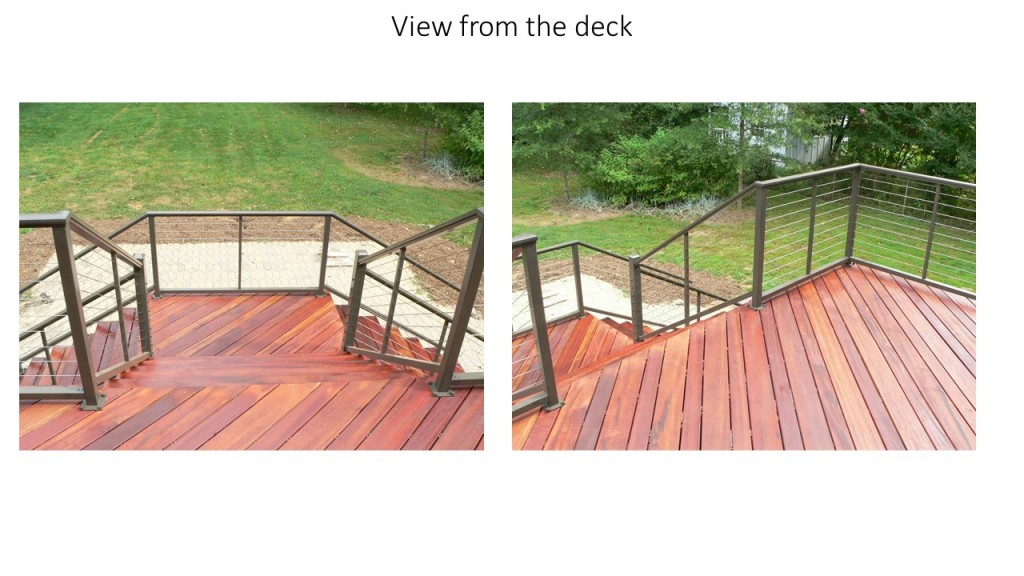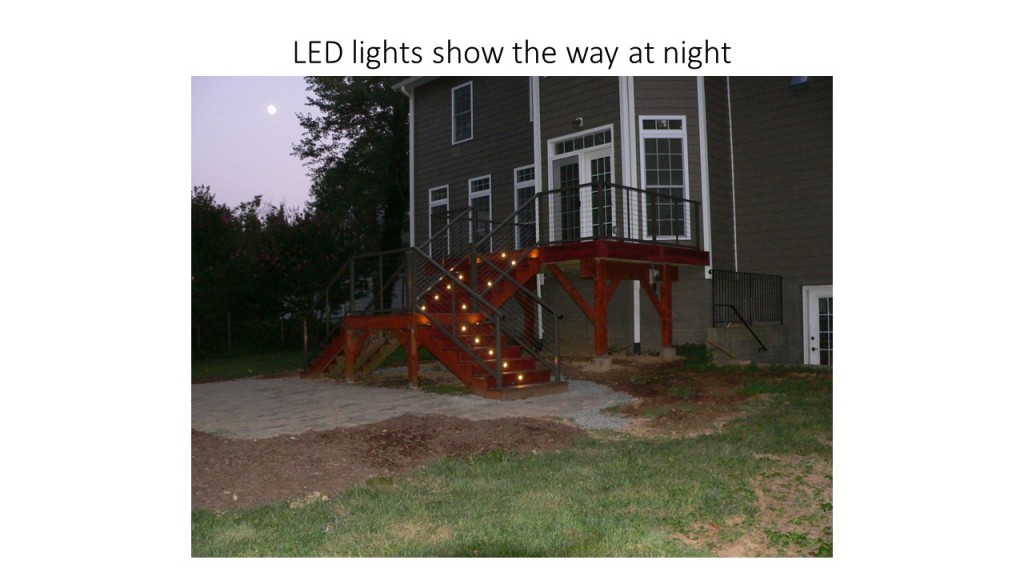What I built on my summer vacation

As the days got longer and the temperatures began to soar, what a perfect time to start an outdoor project – a paver stone patio and deck. To make sure the pleasure is maximized, mother nature provided the wettest June and July and the hottest July on record for the Metropolitan Washington area .
History
When our new house was finished 4 1/2 years ago, the patio door, located in the center of 14 feet wide octagonal shaped bump out, opened to a 6 1/2 feet drop to the ground. The contractor blocked the exit with a “fence” like structure nailed to the exterior molding of the door. Since taking possession of the house, I have talked and thought about building a deck and stair case to the backyard. Constrains of window locations, steps from the walk-out basement and location of a detached garage were mulled into series of sketches with different size and shape deck structures. This on-again and off-again process went on for 4 years as no design felt right. The breakthrough came when I decided to apply the CI project management methodology and establish the voice of the customer (VOC).
- Egress to the ground was the primary function.
- We did not want the deck to block the backyard garden area view from inside the house.
- Providing a large outdoor living space on the deck was not necessary – nice feature but not necessary. The Washington summers have two characteristics – high humidity and mosquitoes. These unpleasant characteristic limits the living space functionality to few weeks in the Spring and Autumn and an occasional day during the summer months.
- I am not a big fan of grilling on a deck because of damage from grease drips and deck surface damage from hot coals (love using charcoal and wood). I prefer to grill on ground level so I could build a patio area for grilling using the old house’s salvaged paver driveway for the cost of my sweat and some rock and sand (about $150) versus the cost to increase the square footage of the deck to accommodate a grilling area.
- We did not want a treated pine deck surface. Man-made deck materials are not very inspiring (to me) and when you start pricing them you find out real fast pretty they are an expensive alternative to wood. I found a source of tropical hardwood decking (http://www.advantagelumber.com/) that provided a hardwood decking material that was cost competitive with the higher quality TREX deck material. I could use a smaller size deck surface as a cost containment method to justify a premium deck surface instead of treated pine.
- We did not want a railing system that made you feel like you are looking out of a prison cell. We liked the open view provided by either glass panels or the stainless steel cable railing. The glass panel is expensive and the only person I talked to that had a deck with this railing restrain said that it was a pain to keep the glass clean. Seeing displays at a building supplier’s showroom proved that the cable rail system provided the desired unobstructed view and clean lines. Because the system is priced by the foot, anything that minimized size made this choice financially feasible.
- When I started investigating the current building code requirements (Design of Code Acceptance (6) International Residential Code 2012 by the American Wood Council), the number of footers for a larger deck would make this a excavation and concrete pouring project instead of wood construction project. The larger deck plan would require at least 9 footers (or more as the size increased) plus 8 footers for the stairs landings instead of 4 footers and the 8 stair landing footers for a smaller deck. Since I represented the excavator, I wanted to minimize the number of footers – later I will tell you why this was one of the better choice I made during the project.
After the VOC, she who must be obeyed and I compromised on a nominal 14 feet by 7 feet deck surface that had descended to a 12 feet by 17 feet paver patio surface. Plans for the deck were drawn (none required for the patio) and submitted to the building code office. After languishing for 3 weeks, the plans were approved and a permit issued on June 3, 2015. The next day the temperature went to 90 + F and except for a occasional break, remained the day time norm temperature for the project’s duration.
Because I had to move a pile of gravel that was salvaged during the construction of the paver driveway on the current house, the patio was constructed before the deck. I rented a backhoe to move six inches of top soil and then grade the patio location with the gravel. To ensure drainage I used a 1/4 inch drop per linear foot grade. After I returned the backhoe, She who must be obeyed decided to survey the project and promptly announced that she felt like she was falling over because of the gradient. So the gradient was changed to 1/8 inch per foot by adding gravel from a secondary salvaged gravel pile. Of course, without a backhoe, the transportation method was shovel and wheelbarrow – it was only 85 degrees at 6 am for this physical work out – my middle names are cheap and stupid. The patio required 186 pavers to be moved from storage and laid in their final resting place.
Three days later I am ready to start digging the footers for the main deck. While I had the backhoe I dug two trenches where the deck footers would be located. The deep end next to the house extended over 4 feet down until I found the house footing. The trench sloped up to a depth of about 32 inches when it reached a distance about 7 feet from the house. I later regretted not digging the trench a constant four feet depth when the footers failed the building inspection because the soil did not meet the “non-disturbed” soil requirement. The footers were located in the area the contractor had excavated for the basement stair area way. The area also was the place that the contractor used to “hide” much of the concrete/landscape debris from the old house teardown. To reach undisturbed soil from the bottom of the origin 32 inches trench to the eventual 4 1/2 feet depth required 3 hours to extract the concrete and wood debris. The stair landing footers were dug after construction of the main deck determined their exact locations. Of the 12 footers eventually dug, only one was not obstructed by some type of debris and 9 of the 12 required depths of about 4 feet to find undisturbed soil. In the end I removed over 5 wheelbarrow loads of rock, concrete and wood debris left by the contractor. The increased depth increased the amount of required concrete to form the footers and support piers from about 3/4 cubic yards to about 1.25 cubic yards.
If I had been paid by the 32 ounces bottle of water consumed, I could have paid for the deck and had enough left over for vacation. The day time high temperature for this part of the project was over 90 degrees and the dew point was often about 65 degrees at 6 AM when I would start the day. Age and weather restricted my work time to about 5 hours a day and resulted in 11 work days to complete all the foundation work and get ready to actually build the deck. The only advantage I found from this portion of the project is I lost about 12 pounds of excess weight. I also noted that if I had been required to dig deeper or more holes I could have lost all 210 pounds of excess weight and the second husband could have finished the project with the life insurance money.
The deck construction was pretty straightforward framing for a free standing deck (did not want to use ledger construction that would require the remove of three course of the HardiPlank siding). The tigerwood deck boards were received but 8 boards were damaged during shipping so the project was slightly delayed while the vendor reshipped the replacement boards. The installation was uneventful.
I ordered an aluminum railing system with stainless steel cable infills Nexan Building Products. The system is engineered to meet building code requirements and it is custom fitted to the deck’s dimensions. The downside of the system is it is pricey but when I factored in the cost of wood post, lumber and post anchoring hardware required by the building code the cost became reasonable. When you add the aluminum railings are essentially maintenance free, the cost was not that great. After receiving the system, I discovered that I probably saved about two days installation time compared to using custom built wood. i Installation was simple and installation instructions were clear and simple to follow.
I added a low voltage deck lighting systems to the stairs from Dekor. The LED lights are great illuminators.
So after 10 weeks we have a finished deck and final building inspection completed. Now I only have to enjoy the new deck and pay the property taxes on the new assessment.




